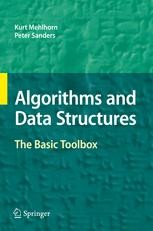link.springer.com/10.1007/978-3-540-77978-0
Preview meta tags from the link.springer.com website.
Linked Hostnames
17- 48 links tolink.springer.com
- 11 links towww.springernature.com
- 3 links tosupport.springernature.com
- 2 links toscholar.google.co.uk
- 2 links tosingle-ebooks.springernature.com
- 2 links towww.ncbi.nlm.nih.gov
- 1 link toauthorservices.springernature.com
- 1 link toextras.springer.com
Thumbnail

Search Engine Appearance
Algorithms and Data Structures
Algorithms are at the heart of every nontrivial computer application, and algorithmics is a modern and active area of computer science. Every computer scientist and every professional programmer should know about the basic algorithmic toolbox: structures that allow efficient organization and retrieval of data, frequently used algorithms, and basic techniques for modeling, understanding and solving algorithmic problems. This book is a concise introduction addressed to students and professionals familiar with programming and basic mathematical language. Individual chapters cover arrays and linked lists, hash tables and associative arrays, sorting and selection, priority queues, sorted sequences, graph representation, graph traversal, shortest paths, minimum spanning trees, and optimization. The algorithms are presented in a modern way, with explicitly formulated invariants, and comment on recent trends such as algorithm engineering, memory hierarchies, algorithm libraries and certifying algorithms. The authors use pictures, words and high-level pseudocode to explain the algorithms, and then they present more detail on efficient implementations using real programming languages like C++ and Java. The authors have extensive experience teaching these subjects to undergraduates and graduates, and they offer a clear presentation, with examples, pictures, informal explanations, exercises, and some linkage to the real world. Most chapters have the same basic structure: a motivation for the problem, comments on the most important applications, and then simple solutions presented as informally as possible and as formally as necessary. For the more advanced issues, this approach leads to a more mathematical treatment, including some theorems and proofs. Finally, each chapter concludes with a section on further findings, providing views on the state of research, generalizations and advanced solutions.
Bing
Algorithms and Data Structures
Algorithms are at the heart of every nontrivial computer application, and algorithmics is a modern and active area of computer science. Every computer scientist and every professional programmer should know about the basic algorithmic toolbox: structures that allow efficient organization and retrieval of data, frequently used algorithms, and basic techniques for modeling, understanding and solving algorithmic problems. This book is a concise introduction addressed to students and professionals familiar with programming and basic mathematical language. Individual chapters cover arrays and linked lists, hash tables and associative arrays, sorting and selection, priority queues, sorted sequences, graph representation, graph traversal, shortest paths, minimum spanning trees, and optimization. The algorithms are presented in a modern way, with explicitly formulated invariants, and comment on recent trends such as algorithm engineering, memory hierarchies, algorithm libraries and certifying algorithms. The authors use pictures, words and high-level pseudocode to explain the algorithms, and then they present more detail on efficient implementations using real programming languages like C++ and Java. The authors have extensive experience teaching these subjects to undergraduates and graduates, and they offer a clear presentation, with examples, pictures, informal explanations, exercises, and some linkage to the real world. Most chapters have the same basic structure: a motivation for the problem, comments on the most important applications, and then simple solutions presented as informally as possible and as formally as necessary. For the more advanced issues, this approach leads to a more mathematical treatment, including some theorems and proofs. Finally, each chapter concludes with a section on further findings, providing views on the state of research, generalizations and advanced solutions.
DuckDuckGo
Algorithms and Data Structures
Algorithms are at the heart of every nontrivial computer application, and algorithmics is a modern and active area of computer science. Every computer scientist and every professional programmer should know about the basic algorithmic toolbox: structures that allow efficient organization and retrieval of data, frequently used algorithms, and basic techniques for modeling, understanding and solving algorithmic problems. This book is a concise introduction addressed to students and professionals familiar with programming and basic mathematical language. Individual chapters cover arrays and linked lists, hash tables and associative arrays, sorting and selection, priority queues, sorted sequences, graph representation, graph traversal, shortest paths, minimum spanning trees, and optimization. The algorithms are presented in a modern way, with explicitly formulated invariants, and comment on recent trends such as algorithm engineering, memory hierarchies, algorithm libraries and certifying algorithms. The authors use pictures, words and high-level pseudocode to explain the algorithms, and then they present more detail on efficient implementations using real programming languages like C++ and Java. The authors have extensive experience teaching these subjects to undergraduates and graduates, and they offer a clear presentation, with examples, pictures, informal explanations, exercises, and some linkage to the real world. Most chapters have the same basic structure: a motivation for the problem, comments on the most important applications, and then simple solutions presented as informally as possible and as formally as necessary. For the more advanced issues, this approach leads to a more mathematical treatment, including some theorems and proofs. Finally, each chapter concludes with a section on further findings, providing views on the state of research, generalizations and advanced solutions.
General Meta Tags
11- titleAlgorithms and Data Structures: The Basic Toolbox | SpringerLink
- charsetUTF-8
- X-UA-CompatibleIE=edge
- viewportwidth=device-width, initial-scale=1
- applicable-devicepc,mobile
Open Graph Meta Tags
5- og:urlhttps://link.springer.com/book/10.1007/978-3-540-77978-0
- og:typebook
- og:site_nameSpringerLink
- og:titleAlgorithms and Data Structures
- og:imagehttps://media.springernature.com/w153/springer-static/cover/book/978-3-540-77978-0.jpg
Item Prop Meta Tags
2- position1
- position2
Link Tags
9- apple-touch-icon/oscar-static/img/favicons/darwin/apple-touch-icon-6ef0829b9c.png
- canonicalhttps://link.springer.com/book/10.1007/978-3-540-77978-0
- icon/oscar-static/img/favicons/darwin/android-chrome-192x192.png
- icon/oscar-static/img/favicons/darwin/favicon-32x32.png
- icon/oscar-static/img/favicons/darwin/favicon-16x16.png
Links
79- http://scholar.google.co.uk/scholar?as_q=&num=10&btnG=Search+Scholar&as_epq=&as_oq=&as_eq=&as_occt=any&as_sauthors=%22Kurt+Mehlhorn%22&as_publication=&as_ylo=&as_yhi=&as_allsubj=all&hl=en
- http://scholar.google.co.uk/scholar?as_q=&num=10&btnG=Search+Scholar&as_epq=&as_oq=&as_eq=&as_occt=any&as_sauthors=%22Peter+Sanders%22&as_publication=&as_ylo=&as_yhi=&as_allsubj=all&hl=en
- http://www.ncbi.nlm.nih.gov/entrez/query.fcgi?cmd=search&term=Kurt+Mehlhorn
- http://www.ncbi.nlm.nih.gov/entrez/query.fcgi?cmd=search&term=Peter+Sanders
- https://authorservices.springernature.com/go/sn/?utm_source=SNLinkfooter&utm_medium=Web&utm_campaign=SNReferral